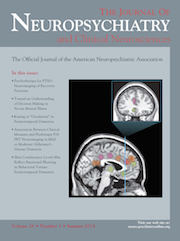Russell’s Sign in Persistent Delusional Disorder: A Case Report
To the Editor: Induced vomiting has been classically described in association with bulimia nervosa.1 As a consequence of chronic induced vomiting, patients develop callosity in the knuckles and in the back of their hands, which is known as Russell’s sign.2,3 This sign has not been described in association with other psychiatric disorders. Presence of these physical signs can give important clues regarding the nature of underlying illness to the treating psychiatrist. We describe a case of 55-year-old woman with a 14-year history of persistent delusional disorder presenting with Russell’s sign as a result of persistent induced vomiting secondary to persecutory delusions.
Case Report
“Mrs. P,” a 55-year-old married woman, presented to the outpatient services of the Department of Psychiatry of our hospital with complaints of being suspicious toward her family members, refusing to eat food served by them and repeated self-induced vomiting for the past 14 years. She firmly believed that her family members were mixing a long-acting poison in her food in order to harm her. She acted out on this belief by trying to induce vomiting after eating food to negate the effects of the poison. She would brush her teeth after every meal in an attempt to remove the poison that might be sticking to her teeth. She would also try to cough out the poisonous particles, which she believed were present in her lungs. She had confined herself to the house, had minimal social interactions, and also did not perform her role as a homemaker satisfactorily during the last 14 years. She had resisted all previous attempts by family members to seek psychiatric help. Her birth and developmental history was unremarkable. There was no family history of psychotic disorder. Premorbidly, she had paranoid personality traits.
Mental status examination revealed a single, elaborate persecutory delusion against her family members. General examination revealed multiple callosities over bilateral knuckles (Figure 1). On inquiry, she revealed that she generally used the back of her hand to repeatedly induce vomiting over the years, which she did secretively. She did not have any other skin lesions. Systemic physical examination did not reveal any abnormality. Her hemogram and biochemical parameters inclusive of electrolytes, renal, liver, and thyroid functions were normal. Fasting (140 mg/dl) and postprandial blood sugars (250 mg/dl) were elevated and were in the diabetic range.

Dermatologist opinion was obtained who concurred that the skin lesions were callosities as a result of recurrent friction and was not suggestive of skin changes associated with diabetes mellitus. There were no themes of contamination associated with these beliefs, and she did not consider her action of inducing vomiting to be excessive or irrational. There was no associated preoccupation with body weight or shape or binge eating. She was diagnosed with persistent delusional disorder according to ICD-10 criteria along with diabetes mellitus.
She was started on tablet aripiprazole 30 mg/day in view of her metabolic status. An opinion from a physician was obtained, and she was started on oral hypoglycemic agent, metformin 1000 mg/day. During the course of her admission, her irritability toward family members improved gradually and she was compliant with her treatment regimen. On follow- up after a period of 6 months, the intensity of her beliefs had reduced. She still reported her persecutory delusions on interview; however, her acting out behavior of induced vomiting had completely stopped. Improvement was also observed in her social interaction.
Discussion
Russell’s sign has been classically described only in association with eating disorders. To the best of our knowledge, this is the first report of Russell’s sign in a patient with persistent delusional disorder. The index patient had presented with chronic untreated illness of 14 years duration characterized by delusions of persecution, social withdrawal, and recurrent self-induced vomiting. The induced vomiting was a part of acting out behavior in response to her delusional belief that her food was being poisoned. The chronic induced vomiting had resulted in callosities at the back of her hand. In the psychiatric setting, the common differential diagnosis to be considered in a patient with recurrent induced vomiting includes eating disorders, and obsessive compulsive and related spectrum disorders. Both of these could be ruled out in this case as she did not consider this behavior to be excessive or irrational, and the behavior was secondary to her delusional beliefs and there were no body image disturbances. The finding of Russell’s sign in this patient reflects the severity of her acting out beliefs and chronicity of her illness. This case highlights the importance of physical signs in evaluation of psychiatric disorders, which can give important clues to the treating psychiatrist.
1 : Long-term outcome of bulimia nervosa. Arch Gen Psychiatry 1999; 56:63–69Crossref, Medline, Google Scholar
2 : Eating disorders: clinical features and pathophysiology. Physiol Behav 2004; 81:359–374Crossref, Medline, Google Scholar
3 : Bulimia nervosa: an ominous variant of anorexia nervosa. Psychol Med 1979; 9:429–448Crossref, Medline, Google Scholar



